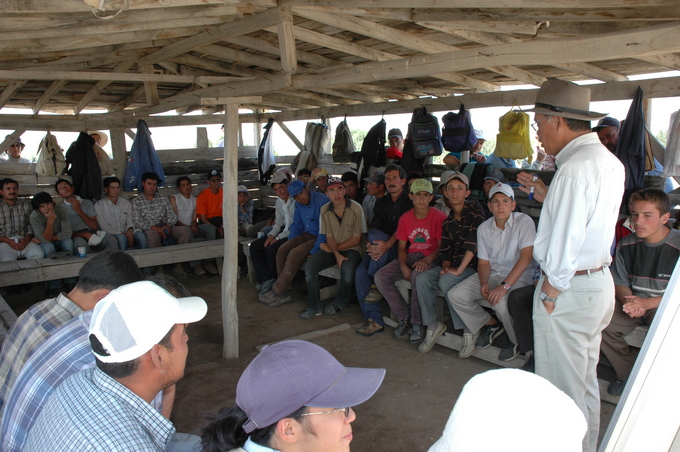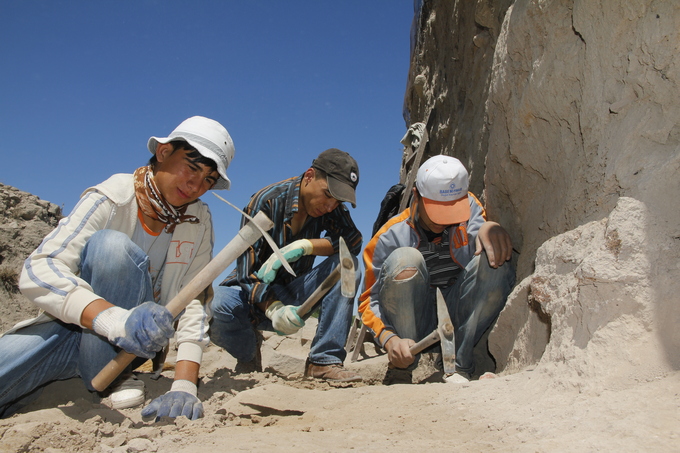Museum of Archaeology Kaman-Kalehöyük: Excavation Strengthens Ties between Countries
Sachihiro Omura,
Director of Japanese Institute of Anatolian Archaeology, Middle Eastern Culture Center in Japan
Construction of the Museum of Archaeology Kaman-Kalehöyük began in 2008 with the help of Cultural Grant Assistance received from Japan's Foreign Ministry the previous year, and the museum opened officially on July 10, 2010. Since 2009, the Japan Foundation, in cooperation with the Middle Eastern Culture Center in Japan's Japanese Institute of Anatolian Archaeology, has dispatched exhibition specialist Hirofumi Nagakane of Dig Inc. three times to the museum, where he instructed young Turkish curators in museum display techniques. In this article, Omura gives an account of how the archaeological museum, now an important research base, educational facility for children, and community information center, came into being.
Why conduct excavations in central Turkey?
I have lost count of the number of time I've been asked "Why are you digging in Turkey?" by local children during an excavation. Many people still believe that gold and precious items can be found in archaeological sites, and when we first began, my claim that I was not there to find buried treasures was met with disbelief by all members of the local community. On the Anatolian Plateau, which covers about 93 percent of the area of the Republic of Turkey, there are innumerable mounded sites called huyuk, hoyuk, kale, or tepe. Since 1986, the Japanese Institute of Anatolian Archaeology has engaged in excavations at Kaman-Kalehöyük site in the central region of the Anatolian Plateau. With this year, a quarter-century has passed since we started our investigations.
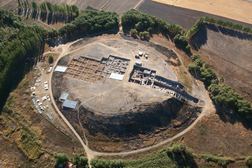 The chronology of the site spans a period of over 9000 years, and we have found more than 40 occupation levels, the remains of cities built on top of each other. As we dug down, we found layer upon layer of ruins of urban settlements. Each ancient city had its own unique artifacts. The primary goal of this excavation is the creation of a "cultural chronology," an archaeological timeline of the site, through careful and systematic digging. At present we have completed a chronology of about 4000 years.
The chronology of the site spans a period of over 9000 years, and we have found more than 40 occupation levels, the remains of cities built on top of each other. As we dug down, we found layer upon layer of ruins of urban settlements. Each ancient city had its own unique artifacts. The primary goal of this excavation is the creation of a "cultural chronology," an archaeological timeline of the site, through careful and systematic digging. At present we have completed a chronology of about 4000 years.
Since the Anatolian Plateau is located at a cultural crossroads linking the east, west, north, and south, there were artifacts from other regions in each stratum which were indicative of particular time periods. Such artifacts are very important as they serve as markers in constructing the timeline of the site.
A constant source of worry for research institutions excavating in Anatolia is the illegal digging by looters which occurs after an excavation season has ended. It is very painful to view a site which we had excavated with utmost care only yesterday, being ravaged by looters with pickaxes. Guards have been stationed at every site and laws to protect the sites are being considered, but there has been no improvement in the situation as yet.
Archaeology Classes
The "children" who helped us in the excavation (actually young workers in their teens and twenties; in Turkish they are called çocuklar, children) did not understand what we meant when we talked about making a chronology of the site. During the excavation of Kaman-Kalehöyük site we held "archaeology" classes for these children every Friday. We began the classes in 1986, which means the program has been going on for 20 years. I began the classes because I felt that there was no point in having them work without an understanding of what an archaeological dig was. In the beginning, I repeatedly instructed them on excavation skills. They did not have any experience, so it was necessary to explain how to use shovels and wheelbarrows. From this starting point we went on to other things such as how to classify and record artifacts, surveying techniques, and so on, and as we taught them their level of understanding improved considerably.
After a few years of these classes their understanding of archaeology had advanced significantly, but now they began to ask the very difficult question, "Why do you excavate?" I was hard put to answer this question. My motivations could not be expressed easily in words, and even if I could do so, it was doubtful whether the children would understand.
As mentioned above, the Kaman-Kalehöyük site contains many cultural layers. It is necessary to excavate each layer carefully, starting with the topmost and working down. By studying their sequence we can trace the transition of each culture through time. To put it simply, it is sometimes possible to understand, among other things, why a particular culture flourished and how it declined and ended. For me, this is the most fulfilling moment in an excavation. When I talked of such matters in my classes, using the artifacts and features of the Kaman-Kalehöyük site as examples, I noticed how much more interested the children became when the actual artifacts were placed in front of them. This experience was at the back of my mind when I first conceived the idea of building a museum.
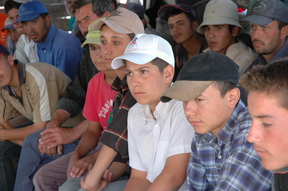 An excavation unearths great quantities of pottery, animal and human bones, iron, bronze, gold and lead artifacts, stone implements, glass, seeds, coins, clay tablets, and so on. The amount of material is truly enormous. Our archaeology classes are conducted not only for the children of the local community who work with us, but also for children who come to visit the site. The following incident occurred one day. Some elementary school students wanted to try their hands at excavation, so I let them do some digging. Even now I vividly remember the expression of joy on the face of a child who had found a human bone fragment. Holding the bone in his hand, his expression was one of pure happiness. He held the piece in his hand until the end of the class, and when he handed it to me I will never forget his words. He said, "Mr. Omura, can I see this bone again when I come next time?"
An excavation unearths great quantities of pottery, animal and human bones, iron, bronze, gold and lead artifacts, stone implements, glass, seeds, coins, clay tablets, and so on. The amount of material is truly enormous. Our archaeology classes are conducted not only for the children of the local community who work with us, but also for children who come to visit the site. The following incident occurred one day. Some elementary school students wanted to try their hands at excavation, so I let them do some digging. Even now I vividly remember the expression of joy on the face of a child who had found a human bone fragment. Holding the bone in his hand, his expression was one of pure happiness. He held the piece in his hand until the end of the class, and when he handed it to me I will never forget his words. He said, "Mr. Omura, can I see this bone again when I come next time?"
This experience was the true motivation behind my decision to build the Kaman-Kalehöyük museum. I thought it would be a real pleasure to give archaeology classes in a museum context, using the artifacts excavated from the site. If I could teach the local children in such an environment, I would enjoy it so much that I might lose track of time. The idea to construct the museum came about as a result of many years of giving classes for local children. Therefore it is not an exaggeration to say that the children were responsible for the creation of the museum.
Construction of Kaman-Kalehöyük Museum Funded by Japan ODA
The Kirşehir Archaeology Museum did not have adequate facilities for the exhibition of archaeological material, so most of our artifacts had been placed in storage. It was very unfortunate that this material was hidden away from the public for more than 20 years. The ideal environment for archaeological research is to have facilities to study the excavated material and a museum to display the artifacts in close proximity to a site. Of course this is not easily achieved. But thanks to the assistance provided by many people, the creation of this museum has enabled us to approach this ideal.
Former Ambassador Atsuko Toyama was especially supportive of our museum project. And since the year 2000, His Imperial Highness Prince Tomohito has done much to assist us in constructing the facilities of the Japanese Institute of Anatolian Archaeology. Without the fundraising committee established by the Prince, we could not have succeeded in the creation of either the institute or the museum.
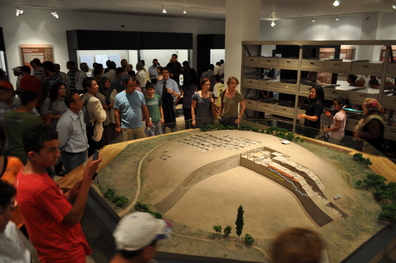 Construction of the building itself was funded through Japan ODA, but expenses for display cases and setting up the exhibits were covered by the Turkish government. Furthermore, for the installation of the exhibits, the Japan Foundation provided us with the services of Hirofumi Nagakane, a cultural facilities exhibition planner. He assisted us in preparing display cases, explanation panels, and exhibits of artifacts, and most importantly, explained carefully to the Turkish curators the methods used for each installation. I was especially impressed by Nagakane's hands-on approach to instruction. It is not enough just to learn the theory. It was an illuminating experience to watch the Turkish staff learning from an expert first-hand and to see them trying out the same techniques by themselves, and I felt that this was the best way to pass down skills to succeeding generations. When the exhibits were completed, the Turkish curators were extremely happy and shared their joy with Nagakane, saying that they had learned new techniques which were different from the traditional methods used in other Turkish museums. I felt that we were able to establish a precedent for museum displays and cultural property preservation. I am confident that our young Turkish curators will exert a major influence and play a central role in future museum exhibitions.
Construction of the building itself was funded through Japan ODA, but expenses for display cases and setting up the exhibits were covered by the Turkish government. Furthermore, for the installation of the exhibits, the Japan Foundation provided us with the services of Hirofumi Nagakane, a cultural facilities exhibition planner. He assisted us in preparing display cases, explanation panels, and exhibits of artifacts, and most importantly, explained carefully to the Turkish curators the methods used for each installation. I was especially impressed by Nagakane's hands-on approach to instruction. It is not enough just to learn the theory. It was an illuminating experience to watch the Turkish staff learning from an expert first-hand and to see them trying out the same techniques by themselves, and I felt that this was the best way to pass down skills to succeeding generations. When the exhibits were completed, the Turkish curators were extremely happy and shared their joy with Nagakane, saying that they had learned new techniques which were different from the traditional methods used in other Turkish museums. I felt that we were able to establish a precedent for museum displays and cultural property preservation. I am confident that our young Turkish curators will exert a major influence and play a central role in future museum exhibitions.
How the Museum has Benefited the Local Community
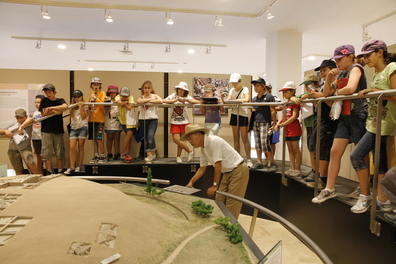 Construction on the Kaman-Kalehöyük Museum commenced in April 2008, and was completed in March 2009, after which the museum was handed over to the Ministry of Culture and Tourism of Turkey in April of the same year. And on July 10, 2010, its opening ceremony was graced by the presence of His Imperial Highness Prince Tomohito and Her Imperial Highness Princess Akiko. It was a grand occasion, attended by more than 3000 people. After the ceremony, the museum was opened to the public, an event that had been long awaited by the local community. They viewed the displays with great enthusiasm. Since then, the museum has been filled with visitors every day. Without doubt, the museum has become an important part of the local community. I believe that the wonderful exhibition techniques taught by Nagakane have contributed in a large part to this popularity. Every Sunday afternoon I act as a museum guide. Sometimes some children working at the excavation, especially those in middle school, will appear with their families. The sight of them describing the artifacts to their mothers is heartwarming. It is very touching to see them proudly explaining each item. I am sure that they will protect the site and museum throughout the years ahead, and never let them be neglected. I believe that the passing of laws to protect cultural properties is one way of keeping them safe, but it is more important to educate community members on the value of cultural properties, through the creation of institutions such as museums.
Construction on the Kaman-Kalehöyük Museum commenced in April 2008, and was completed in March 2009, after which the museum was handed over to the Ministry of Culture and Tourism of Turkey in April of the same year. And on July 10, 2010, its opening ceremony was graced by the presence of His Imperial Highness Prince Tomohito and Her Imperial Highness Princess Akiko. It was a grand occasion, attended by more than 3000 people. After the ceremony, the museum was opened to the public, an event that had been long awaited by the local community. They viewed the displays with great enthusiasm. Since then, the museum has been filled with visitors every day. Without doubt, the museum has become an important part of the local community. I believe that the wonderful exhibition techniques taught by Nagakane have contributed in a large part to this popularity. Every Sunday afternoon I act as a museum guide. Sometimes some children working at the excavation, especially those in middle school, will appear with their families. The sight of them describing the artifacts to their mothers is heartwarming. It is very touching to see them proudly explaining each item. I am sure that they will protect the site and museum throughout the years ahead, and never let them be neglected. I believe that the passing of laws to protect cultural properties is one way of keeping them safe, but it is more important to educate community members on the value of cultural properties, through the creation of institutions such as museums.
When the artifacts excavated from the site are put on display, the young workers who found them can have the pleasure of showing them off to their families and friends. That alone justifies the building of the museum. Incidentally, looting at the sites, a common occurrence in the Kaman region in the 1980s, has all but disappeared today. Although I do not think that this outcome is entirely due solely to our efforts in the archaeology classes, we have felt great gratification at this fact.
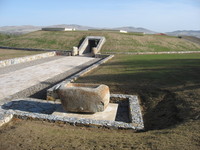 * The Museum of Archaeology Kaman-Kalehöyük
* The Museum of Archaeology Kaman-Kalehöyük
The Museum of Archaeology Kaman-Kalehöyük is located in Çağirkan Village in Kirşehir province in Turkey and was constructed with funding by the ODA of the Ministry of Foreign Affairs of Japan. The museum opened on July 10, 2010 with an opening ceremony attended by His Imperial Highness Prince Tomohito and Her Imperial Highness Princess Akiko. The museum building was designed after the mounded shape of the Kaman-Kalehöyük site, and houses a library, a facility for the preservation and restoration of artifacts, and a repository, with a total area of 1,421 square meters.
Most of the exhibits have been unearthed from Kaman-Kalehöyük site, and the artifacts are exhibited in a sequence from the late (recent) to early periods (Stratum I of the Ottoman Empire Period; Stratum II of the Iron Age; Stratum III of the Middle and Late Bronze Ages, and Stratum IV of the Early Bronze Age), with a scale model display of the site in the center of the exhibition hall. By viewing the exhibits in this order, the visitor will come to understand the cultural chronology of the site (the timeline of the history of Anatolia). The goal of the museum is to serve as an institution for research and practice in the preservation and restoration of artifacts from archaeological sites, and to perform a leading role in enlightening the public on archaeology.
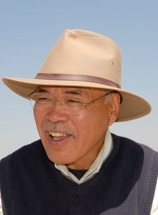 Sachihiro Omura
Sachihiro Omura
Director of Japanese Institute of Anatolian Archaeology, Middle Eastern Culture Center in Japan
Omura has been involved in the archaeological excavation of Kaman-Kalehöyük site, located in the approximate center of the Republic of Turkey, since 1985. He has discovered a culture layer which may shed light on the so-called "Dark Age" of Anatolian archaeology, and is presently engaged in its excavation. Books include Tetsu o umidashita teikoku (The iron-producing empire) and Anatoria hakkutsu ki (A record of excavation in Anatolia), both from NHK Publishing, Inc.
Related Events
Back Issues
- 2022.11. 1 Inner Diversity<3> <…
- 2022.9. 5 Report on the India-…
- 2022.6.24 The 48th Japan Found…
- 2022.6. 7 Beyond Disasters - …
- 2021.3.10 Crossing Borders, En…
- 2020.7.17 A Millennium of Japa…
- 2020.3.23 A Historian Interpre…
- 2019.11.19 Dialogue Driven by S…
- 2019.10. 2 The mediators who bu…
- 2019.6.28 A Look Back at J…


